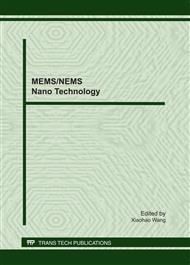p.53
p.58
p.62
p.66
p.70
p.75
p.78
p.83
p.89
A Monolithic MEMS Accelerometer Process
Abstract:
A monolithic MEMS accelerometer process was established. This process successfully combines our standard BiCMOS technology and MEMS surface micromachining technique. The acceleration sensing element is a kind of comb-finger structure which is built by polysilicon surface micromachining technique. The polysilicon structure is designed to form two capacitors for acceleration sensing. The external acceleration will cause the value of two capacitors to vary in different direction. That means one reduces if the other increases. It was integrated with the signal conditioning circuit. In a single die, the active devices including vertical NPN, lateral PNP, PMOS and passive devices such as capacitors, resistors were fabricated which was followed by the steps to form the acceleration sensing structure. The experiment indicates that the fabricated circuit has the function of sensing capacitive variation and with a scale factor of 100mV/g.
Info:
Periodical:
Pages:
70-74
Citation:
Online since:
June 2011
Authors:
Keywords:
Price:
Сopyright:
© 2011 Trans Tech Publications Ltd. All Rights Reserved
Share:
Citation:


